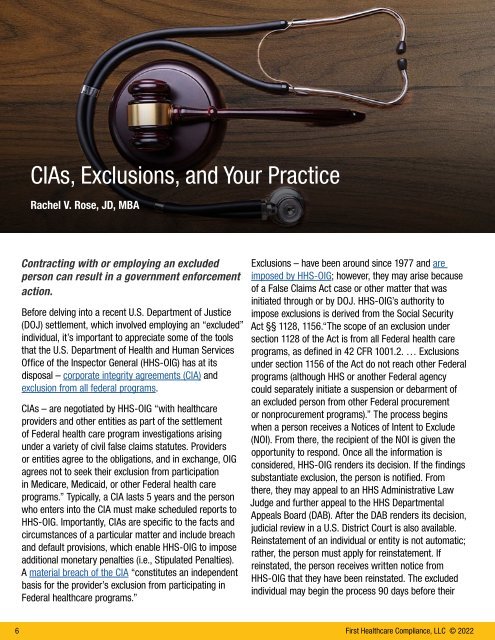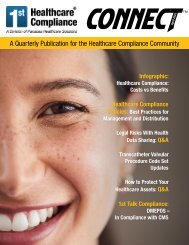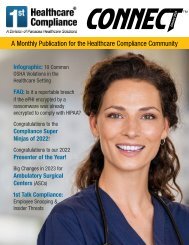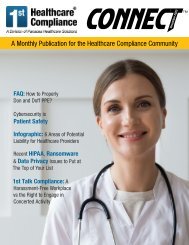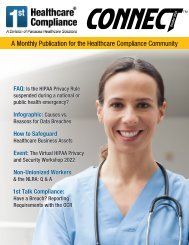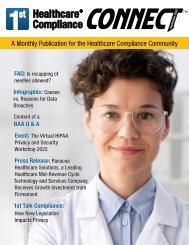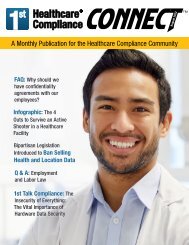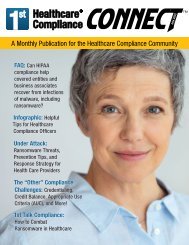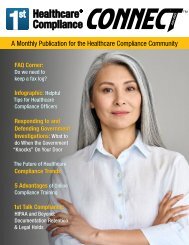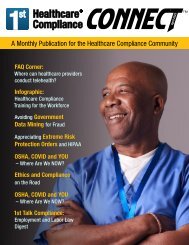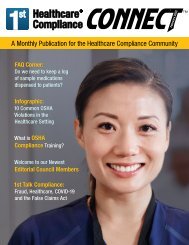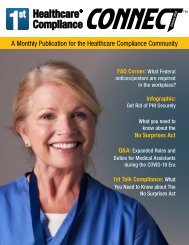First Healthcare Compliance CONNECT May 2022
You also want an ePaper? Increase the reach of your titles
YUMPU automatically turns print PDFs into web optimized ePapers that Google loves.
CIAs, Exclusions, and Your Practice<br />
Rachel V. Rose, JD, MBA<br />
Contracting with or employing an excluded<br />
person can result in a government enforcement<br />
action.<br />
Before delving into a recent U.S. Department of Justice<br />
(DOJ) settlement, which involved employing an “excluded”<br />
individual, it’s important to appreciate some of the tools<br />
that the U.S. Department of Health and Human Services<br />
Office of the Inspector General (HHS-OIG) has at its<br />
disposal – corporate integrity agreements (CIA) and<br />
exclusion from all federal programs.<br />
CIAs – are negotiated by HHS-OIG “with healthcare<br />
providers and other entities as part of the settlement<br />
of Federal health care program investigations arising<br />
under a variety of civil false claims statutes. Providers<br />
or entities agree to the obligations, and in exchange, OIG<br />
agrees not to seek their exclusion from participation<br />
in Medicare, Medicaid, or other Federal health care<br />
programs.” Typically, a CIA lasts 5 years and the person<br />
who enters into the CIA must make scheduled reports to<br />
HHS-OIG. Importantly, CIAs are specific to the facts and<br />
circumstances of a particular matter and include breach<br />
and default provisions, which enable HHS-OIG to impose<br />
additional monetary penalties (i.e., Stipulated Penalties).<br />
A material breach of the CIA “constitutes an independent<br />
basis for the provider’s exclusion from participating in<br />
Federal healthcare programs.”<br />
Exclusions – have been around since 1977 and are<br />
imposed by HHS-OIG; however, they may arise because<br />
of a False Claims Act case or other matter that was<br />
initiated through or by DOJ. HHS-OIG’s authority to<br />
impose exclusions is derived from the Social Security<br />
Act §§ 1128, 1156.“The scope of an exclusion under<br />
section 1128 of the Act is from all Federal health care<br />
programs, as defined in 42 CFR 1001.2. … Exclusions<br />
under section 1156 of the Act do not reach other Federal<br />
programs (although HHS or another Federal agency<br />
could separately initiate a suspension or debarment of<br />
an excluded person from other Federal procurement<br />
or nonprocurement programs).” The process begins<br />
when a person receives a Notices of Intent to Exclude<br />
(NOI). From there, the recipient of the NOI is given the<br />
opportunity to respond. Once all the information is<br />
considered, HHS-OIG renders its decision. If the findings<br />
substantiate exclusion, the person is notified. From<br />
there, they may appeal to an HHS Administrative Law<br />
Judge and further appeal to the HHS Departmental<br />
Appeals Board (DAB). After the DAB renders its decision,<br />
judicial review in a U.S. District Court is also available.<br />
Reinstatement of an individual or entity is not automatic;<br />
rather, the person must apply for reinstatement. If<br />
reinstated, the person receives written notice from<br />
HHS-OIG that they have been reinstated. The excluded<br />
individual may begin the process 90 days before their<br />
6<br />
<strong>First</strong> <strong>Healthcare</strong> <strong>Compliance</strong>, LLC © <strong>2022</strong>


